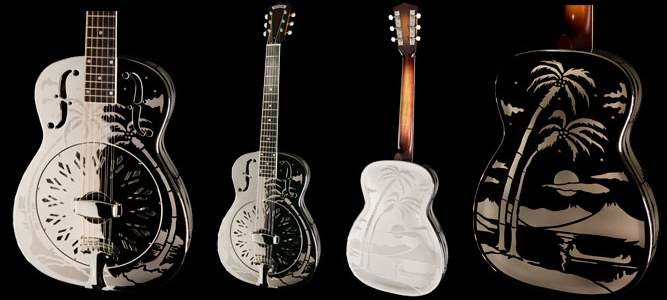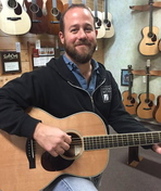 Intricate hand engraved design on the back of a modern National ResoPhonic Tri-cone Guitar Intricate hand engraved design on the back of a modern National ResoPhonic Tri-cone Guitar Once in a while someone will come in our shop and say "hey, why does that guitar have a hubcap on its face?" The first answer is usually "Well sir, that is actually a car, not a guitar, and you might consider updating your prescription lenses." Once the cavalcade of ensuing laughter subsides, we give the real answer which is, as you might have guessed, "why, that's a resophonic guitar!' Invented in the late 1920's to compete with loud banjos and brass instruments, resophonic guitars use an internal aluminum speaker cone to 'amplify' the sound of the guitar. The strings sit on the bridge/saddle which either sits directly on the cone, or on a 'spider' mechanism which in turn rests on the cone. The vibration of the strings causes the cone to flex, just like a speaker cone, and the resulting sound is a louder, more metallic tone than a standard acoustic guitar. There are also 'tri-cone' versions that use three small cones as opposed to one large cone. The tone on these is not quite as loud, but a bit more defined and articulate. National was the first company to bring these to market in 1928 and they soon offered a wide array of models in both single and tri-cone. They made 'Spanish' guitars, tenor & plectrum guitars, 'squareneck' guitars, mandolins, and ukuleles and many of their instruments were adorned with beautiful hand engraved scenes and motifs. Today, National ResoPhonic Guitars in San Luis Obispo carries on the tradition. They manufacture spot-on re-creations of the original National guitars as well as several of their own modern designs and models. Their guitars sound and play as good as the old ones but are even more durable and road worthy, and have modern updates like better tuning gears and truss rods in the neck. Whether you're a beginner or a long time player, if you haven't played a resophonic guitar, you owe it to yourself to try one. So come play a hubcap guitar, it's guaranteed to get your musical wheels spinning! -Mike
0 Comments
Leave a Reply. |



 RSS Feed
RSS Feed



